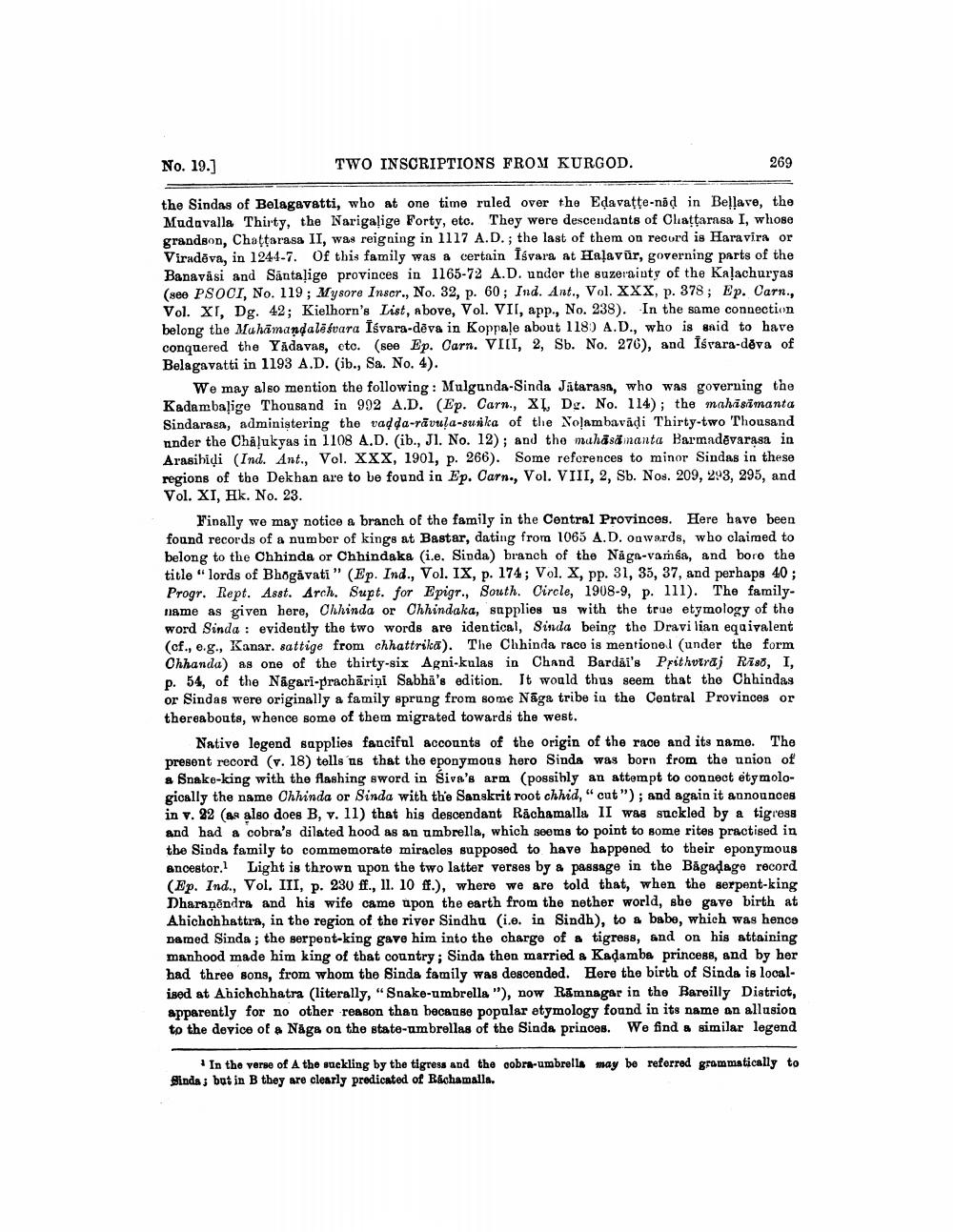________________
No. 19.]
TWO INSCRIPTIONS FROM KURGOD.
269
the Sindas of Belagavatti, who at one time ruled over the Edavatte-nod in Bellave, the Mudavalla Thirty, the Narigaļige Forty, etc. They were descendants of Chattarnsa I, whose grandson, Chattarasa II, was reigning in 1117 A.D.; the last of them on record is Haravira or Viradova, in 1244-7. Of this family was a certain Isvara at Haļavūr, governing parts of the Banavasi and Santalige provinces in 1165-72 A.D. under the suzerainty of the Kalachuryas (see PSOCI, No. 119; Mysore Inscr., No. 32, p. 60; Ind. Ant., Vol. XXX, p. 378; Ep. Carn., Vol. XT, Dg. 42; Kielhorn's List, above, Vol. VII, app., No. 238). In the same connection belong the Mahamandalëfuara Isvara-dēva in Koppale about 1180 A.D., who is snid to have conquered the Yådavas, etc. (see Ep. Carn. VIII, 2, Sb. No. 276), and Israra-dova of Belagavatti in 1193 A.D. (ib., Sa. No. 4).
We may also mention the following: Mulganda-Sinda Jätarasa, who was governing the Kadambalige Thousand in 992 A.D. (Ep. Carn., XI, Dg. No. 114); the mahasimanta Sindarasa, administering the vadda-rāvula-susika of the Nolambavadi Thirty-two Thousand ander the Chalukyas in 1108 A.D. (ib., Jl. No. 12); and the muhasi manta Barmadēvarasa in Arasibiļi (Ind. Ant., Vol. XXX, 1901, p. 266). Some references to minor Sindas in these regions of the Dekhan are to be found in Ep. Carn., Vol. VIII, 2, Sb. Nos. 209, 293, 295, and Vol. XI, Hk. No. 23.
Finally we may notice a branch of the family in the Central Provinces. Here have been found records of a number of kings at Bastar, dating from 1065 A.D. onwards, who claimed to belong to the Chhinda or Chhindaka (i.e. Sinda) branch of the Någn-varsa, and boro the title "lords of Bhogåvati" (Ep. Ind., Vol. IX, p. 174; Vol. X, pp. 31, 35, 37, and perhaps 40 ;
Progr. Rept. Asst. Arch. Supt. for Epigr., South. Oircle, 1908-9, p. 111). The familyname as given here, Chhinda or Chhindaka, sapplies us with the true etymology of the word Sinda : evidently the two words are identical, Sinda being the Dravilian equivalent (cf., e.g., Kanar, sattige from chhattrika). The Chhinda raco is mentional (under the form Ohhanda) as one of the thirty-six Agni-kulas in Chand Bardai's Prithviraj Riso, I, p. 54, of the Nagari-prachāriņi Sabha's edition. It would thus seem that the Chhindas or Sindas were originally a family sprung from some Nāga tribe in the Central Provinces or thereabouts, whonoe some of them migrated towards the west.
Native legend sapplies fanciful accounts of the origin of the race and its name. The present record (v. 18) tells us that the eponymons hero Sinda was born from the union of & Snake-king with the flashing sword in Siva's arm (possibly an attempt to connect etymologically the name Chhinda or Sinda with the Sanskrit root chhid, “cut"); and again it announces in v. 22 (as also does B, v. 11) that his descendant Răchamalla II was suckled by a tigress and had a cobra's dilated hood as an umbrella, which seems to point to some rites practised in the Sinds family to commemorate miracles supposed to have happened to their eponymous ancestor. Light is thrown upon the two latter verses by & passage in the Bågadage record (Ep. Ind., Vol. III, p. 230 ff., 11. 10 ff.), where we are told that, when the serpent-king Dharaņondra and his wife came upon the earth from the nether world, she gave birth at Ahichoh hattra, in the region of the river Sindhu (i.e. in Sindh), to a babe, which was hence named Sinda; the serpent-king gave him into the charge of a tigress, and on his attaining manhood made him king of that country; Sinda then married a Kadamba princess, and by her had three sons, from whom the Sinda family was descended. Here the birth of Sinda is localised at Ahichchhatra (literally, "Snake-umbrella"), now Ramnagar in the Bareilly District, apparently for no other reason than because popular etymology found in its name an allusion to the device of a Näga on the state-umbrellas of the Sinda princes. We find a similar legend
In the verse of A the snekling by the tigress and the cobra-umbrells may be referred grammatically to Ainda, but in B they are clearly predicated of Bachamalla.




